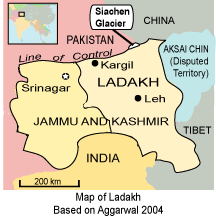Just as expressions of harmony and good feelings often characterize peacefulness in the home and community, constructive statements by political leaders about international relations may sometimes lead to realistic hopes for peace.
The relationship between India and Pakistan, verging dangerously close to large-scale war just a few years ago, has been moving steadily toward peace recently due to the statesmanship of the two national leaders. Fortunately, Ladakh, one of the key areas in the disputed Jammu and Kashmir region, has been the focus of the latest speeches.
Dr. Manmohan Singh, Prime Minister of India, visited Ladakh over the weekend, June 11 – 13, where he laid cornerstones for two small, 45 megawatt hydropower dams, one near Kargil, the major town in the Muslim section of Ladakh, and one near Leh, the center of the Buddhist area. He also opened a road, made various presentations, released a Vision 2025 plan for the development of Ladakh prepared by the Ladakh Autonomous Hill Development Council, and released funds to the LAHDC to support the process.
 The most critical aspects of his visit to Ladakh, however, were his statements bolstering the Indian relationship with Pakistan and his visit with the country’s troops on the Siachen Glacier, at the northeast end of the Line of Control between Pakistan and India. With troops stationed on the glacier between 18,000 and 22,000 feet above sea level, the bitter cold and the altitude have caused more casualties than enemy fire over the past two decades of military occupation.
The most critical aspects of his visit to Ladakh, however, were his statements bolstering the Indian relationship with Pakistan and his visit with the country’s troops on the Siachen Glacier, at the northeast end of the Line of Control between Pakistan and India. With troops stationed on the glacier between 18,000 and 22,000 feet above sea level, the bitter cold and the altitude have caused more casualties than enemy fire over the past two decades of military occupation.
Singh spoke consistently about the permanence of India’s position—he has to maintain his support from his conservative base—but at the same time he made a number of very bold proclamations about the importance of peace in the region. The frequent statements of a peaceful vision, combined with positive steps toward peace, certainly cast a hopeful net over the mountains.
Speaking to the Indian troops at the base camp for the glacier (over 12,000 feet in elevation), Singh said, “Now the time has come and we should try to convert this battlefield into a peace mountain.” Of course in the same speech he ruled out any changes in borders, which are “indispensable for the honour of our country.” Predictably, he told the troops, “I am proud of seeing your patriotism and your determination.”
Comments about patriotism and protecting India’s “honour” would certainly be expected from the leader of a country that has had a hostile relationship with a neighbor for so many years. However, the mixture of nationalism and forceful statements advocating peace was hopeful and refreshing. “But the question arises how long this situation can continue. On the one hand, the youth of this country is protecting the country by sacrificing its happiness and on the other, the troop deployment is affecting the sanctity of the mountains. We should create an atmosphere in which no one perceives any danger and this place becomes an example of perfect peace,” he said.
A peace mountain? A place of perfect peace? These comments would appeal to the Buddhist population, and doubtless to many other Indians. But the remarks by the Indian Prime Minister, perhaps justifiably, were greeted with caution from the other side of the border. “India committed aggression in 1983, it has to vacate the aggression to make Siachen Glacier a peaceful area,” according to a Pakistan Foreign Office representative. Pull your troops off the mountain in order for it to become a “peace mountain.” One of the comments by Singh, that Gilgit and Baltistan were under the control of foreign troops, also provoked the ire of the Pakistani press. Several articles attacked him for implicating that those areas, under the control of Pakistan virtually since independence, were still part of India.
The phrase “peace process,” used indiscriminately by many political leaders in recent decades, has become discredited because of its emptiness, because it has become associated just with political processes that are devoid of true commitments to peace and justice between peoples and nations. Hopefully the people of India and Pakistan will not start using that dreadful phrase, especially with reference to Ladakh. One of the few generalizations that can be made about the peaceful societies is that the people not only strongly believe in peacefulness, they also create real processes—social systems and cultural values—to make sure those beliefs translate into reality.
Prime Minister Singh still has to balance many forces, suspicions, and hostilities in his country, just as President Pervez Musharraf has to do in Pakistan, before additional tentative steps can be taken. But the Prime Minister’s comments over the past weekend were hopeful. He really seems to be articulating a strong belief in peace rather than just empty phrases that a peace process is underway. Whether the two leaders will continue to take positive actions remains to be seen.